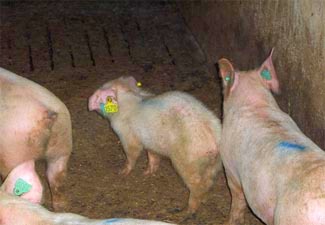Research on the role of the cytokine IL-10 in the development of porcine circovirus

The immunology group of CReSA (Centre de Recerca en Sanitat Animal), UAB-IRTA, describe for the first time the phenotypic characterisation of IL-10 producing cells in a lymphoid organ of pigs with naturally occurring postweaning multisystemic wasting syndrome, a disease which produces growth delay and death during the first months of life of the piglet.
Postweaning multisystemic wasting syndrome (PMWS) is a worldwide distributed disease of pigs with major economic impact in swine production. The essential etiological agent of this condition is a ssDNA virus, the porcine circovirus type 2 (PCV2). However, PMWS is defined as a multifactorial condition, since its occurrence under field conditions usually require a number of risk or triggering factors besides the viral infection.
Interleukin 10 (IL-10) is an anti-inflammatory cytokine, known to be produced by a number of cells from the immune system, including macrophages, dendritic cells (DC), B cells, and various subsets of CD4+ (helper) and CD8+ (cytotoxic) T cells. This cytokine is able to inhibit the activity of T helper cells, natural killer (NK) cells and macrophages, all of which are required for optimal pathogen clearance. Several studies have shown an up-regulation of this cytokine in both subclinically PCV2 and PMWS-affected pigs, suggesting that IL-10 may play a role in the immunosuppression present in the syndrome.
The main objective of this work was to gain further insight into the role of IL-10 in PMWS, studying and characterizing the distribution of different immune cell subpopulations involved in IL-10 secretion in the spleen of naturally occurring PMWS-affected pigs.
Nine 11- to 12-week-old conventional pigs were obtained from commercial farms located in North-Eastern Spain with historical records of PMWS. Spleens from healthy and PMWS-affected animals were collected at necropsy and viral load was determined in serum by means of standard PCR and real-time quantitative PCR. Distribution of different immune cell subpopulations involved in IL-10 secretion in the spleen of studied pigs was analysed using immunofluorescent assays.
The indirect immunofluorescence assays were performed on frozen spleen sections and immunophenotyping of IL-10 producing cells and PCV2-infected cells was performed with specific antibodies. Moreover different cell markers antibodies were used for the phenotyping of the immune subpopulations. Nuclei were counterstained with DAPI.
The more important results were that monocyte/macrophages (CD163+), T helper (CD4+), and cytotoxic T (CD8+) cell subpopulations produced IL-10 in the spleen and IL-10+ cell numbers were higher in PMWS animals compared with their healthy counterparts. Furthermore, IL-10 producing cells were not infected by PCV2 (Fig.2) and were mainly localized in the periarteriolar lymphoid sheaths (PALS), the white pulp of spleen (Fig.3).
Moreover, an association between the number of IL-10+ cells and viremia levels has been observed. Obtained results suggest that the dissimilar amount of IL-10 and PCV2 DNA copies in sera of PMWS-affected animals is probably due to the different evolution stages of the infection.
This study further extend the studies on the role of IL-10 in the immune response to PCV2, supporting the involvement of PCV2-induced IL-10 in PMWS pathogenesis.
References
"Increased numbers of myeloid and lymphoid IL-10 producing cells in spleen of pigs with naturally occurring postweaning multisystemic wasting syndrome." Crisci Elisa, Ballester Maria, Domínguez Javier, Segalés Joaquim and Montoya Maria. Vet Immunol Immunopathol. 2010 Aug 15;136(3-4):305-10. Epub 2010 Mar 17.PMID: 20381172


